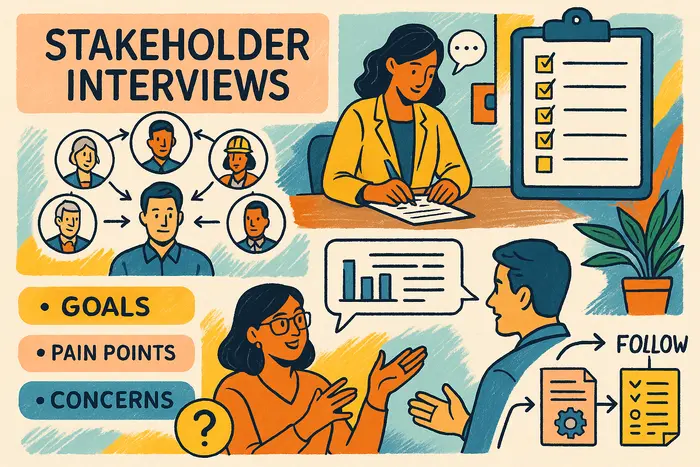Every successful project starts with a solid understanding of what people really need—not just what’s in the brief or the backlog.
And the best way to get that understanding? Talk to your stakeholders.
Stakeholder interviews are a powerful (and underused) way to uncover goals, pain points, risks, and context that no document can fully capture. When done right, they shape smarter solutions, build trust, and save time down the line.
Here’s how to conduct stakeholder interviews that get real results.
What Are Stakeholder Interviews?
Stakeholder interviews are one-on-one conversations with individuals who have a vested interest in the outcome of your project. These might include:
Executives
End users
Subject matter experts
Project sponsors
Department heads
Vendors or partners
The goal is to learn what matters most to them—so you can align your project accordingly.
Why They Matter
Well-run interviews help you:
Understand the business context and priorities
Discover hidden pain points or unmet needs
Clarify conflicting expectations
Spot risks early
Build rapport and trust
They also signal that you’re listening—not just building in a vacuum.
How to Prepare for Stakeholder Interviews
Step 1: Know Who to Interview
Create a quick stakeholder map:
Who are the decision-makers?
Who uses the system or process?
Who supports or maintains it?
Who might resist the change?
Try to include a mix of roles and perspectives.
Step 2: Set Clear Objectives
Before the interview, ask yourself:
What do I need to learn from this person?
What decisions or insights will their input inform?
Tailor your questions to their role and influence.
Step 3: Create an Interview Guide (But Stay Flexible)
Plan your key questions, but don’t script the conversation. Use open-ended prompts to invite real insight.
What to Ask: Sample Questions by Topic
Goals and Expectations
What are you hoping this project will achieve?
What would success look like from your perspective?
Are there any specific outcomes you care most about?
Current State and Pain Points
Walk me through how this process works today.
What are the biggest frustrations or inefficiencies?
What workarounds or manual steps are people doing?
Changes and Concerns
What changes are you worried about?
Have there been past projects like this? What went well or poorly?
What risks do you see if this isn’t done right?
Data and Metrics
Are there key metrics you track related to this?
What reports or insights do you need from the system?
Roles and Responsibilities
Who else should we talk to?
What decisions are you responsible for?
How do you prefer to stay informed or involved?
Requirements and Constraints
Are there rules, policies, or systems we need to consider?
Are there any non-negotiables from your side?
What would you consider a deal-breaker?
Pro Tips for Better Interviews
Listen more than you talk. Resist the urge to jump to solutions.
Record or take notes (with permission).
Ask for examples to clarify vague answers.
Repeat back what you hear to confirm understanding.
Respect their time—stick to 30–45 minutes unless they offer more.
Follow up with a short summary and next steps.
What to Do After the Interview
Summarize key insights: What did you learn? What themes are emerging?
Capture direct quotes: These are great for user stories and stakeholder buy-in.
Document needs and concerns: Tie them to user stories, features, or risks.
Share learnings with your team: Brief notes or a highlight reel can align everyone.
Adjust your approach: Let what you learn shape your project scope, priorities, and communications.
Stakeholder Interview Checklist
- Identified the right people to talk to
- Scheduled with clear purpose and agenda
- Used open-ended, role-specific questions
- Took notes or recorded key points
- Summarized and shared takeaways
- Translated insights into actions, stories, or requirements
Final Takeaway
Stakeholder interviews are one of the simplest ways to uncover powerful insights—if you ask the right questions and truly listen.
“Great analysis starts with great conversations.”
So ditch the assumptions. Book the call. Ask with curiosity. And watch your project get sharper, faster, and more aligned.
